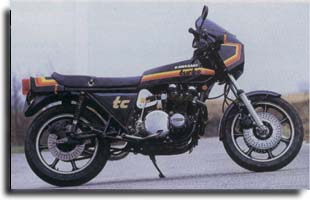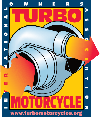|
1978/1979 Kawasaki Z1R-TC Turbos

|
|
|
|
Suggested price in 1978
|
$5,000
|
|
ENGINE
|
|
|
Type
|
Air-cooled, transverse turbocharged four-stroke in-line
four/128 (beastly) RWHP
|
|
Valve arrangement
|
DOHC, 2 valves per cylinder, adjusting shims over buckets
|
|
Carburetion
|
One 38mm modified Facet pumper (modified by ATP)
|
|
Displacement
|
1015cc
|
|
DRIVE TRAIN
|
|
|
Clutch
|
16 wet plates, 5-speed
|
|
Final Drive
|
3/8 x 3/4 inch endless chain
|
|
CHASSIS
|
|
|
Front suspension
|
Kayaba, 5.1-inch travel forks
|
|
Rear suspension
|
Kayaba, 3.5-inch travel twin shocks
|
|
Front tire
|
3.50-18H Dunlop F6
|
|
Rear tire
|
4.00-18H Dunlop K87
|
|
Wet weight
|
558 lbs (253kg)
|
|
Fuel capacity
|
3.4 gallons (13 liters)
|
|
PERFORMANCE
|
|
|
Average touring range
|
119 miles
|
|
Best 1/4 mile acceleration
|
10.90 sec. @ 130 mph ( Motorcyclist , 8/78)
|
|
200 yd. top-gear accel. from 50 mph
|
NA
|
|
Total production
|
Approx. 500 (250 silver-blue in '78, 250 black w/ Molly
graphics in '79)
|
|
Total imported in U.S.
|
Sold only in the U.S.
|
Best
press quote:
"And its
performance--well, it's absolutely shocking. We've never tested
anything that accelerates so fiercely."
Motorcyclist,
August 1978
By
1978 the "King" -- a.k.a Kawasaki's legendary Z1 -- saw its
prior performance supremacy eclipsed by the competition, mainly
Suzuki's GS1000, Honda's CBX, and even Yamaha's XS1100. A bold stroke
was needed -- and fast (pun intended). Hence the Z1RTC Turbo. Though
not a true "factory" product, the Z Turbo nonetheless was
the harbinger of future factory Turbo efforts to follow.
The
Z1RTC was built by the Turbo Cycle Corporation (the TC in Z1RTC)
utilizing American Turbo-Pak (ATP) turbocharging kits. TC Corp.,
headed by former Kawasaki marketing director Alan Masek, essentially
bought the turbocharger units from ATP, bolted them up to existing
Kawasaki Z1Rs and sold them through "select" Kawasaki
dealerships, without warranty (you're on your own, kid). The kits
were essentially basic Z1 kits sold over the counter, however they
featured an improved (No. 370F40) Rayjay turbocharger which utilized
a thicker heat shield separating the turbine and compressor housings
and a new center-bearing that offered improved lubrication. The
turbocharger's wastegate came pre-set to operate at 6-8 lbs. of
boost, but could easily be insanely increased via an adjusting screw
on the bottom of the wastegate. But since the Z1RTC's crank pins were
inexplicably not welded -- a common Z1 performance modification --
your $5,000 investment wouldn't last very long if you got the urge to
"boost up." And you'd undoubtedly need to run racing fuel
to keep the engine from grenading.
In
'78 silver-blue trim the Z1RTC was not exactly a sales success. So
TCC painted the remaining warehoused Turbos jet black and added racy
red/orange/yellow Molly graphics in an effort to make the bikes more
appealing. The marketing ploy worked, but some of the credit had to
go to the bike's growing reputation as a two-wheeled hellraiser. TCC
even added an improved "spider"-type header to replace the
ugly "log"-type unit and the Z1RTCs sold out quickly in
'79. But the euphoria over the bike's new-found showroom success was
short lived as a new law in California made it illegal for dealers to
sell any motorcycles with a modified exhaust system (and a
turbocharger is about as modified as you can get). So there were no
Z1RTCs in 1980 and the "experiment" was dead.
The
Z1RTC performs like you would expect any overly-modified,
hinged-framed, skinny-tired, inadequately-braked motorcycle to
perform. But if you like being scared this is the Turbo for you.
Every card-carrying Z1 collector should have one in his/her garage.
But, alas, there aren't nearly enough to go around. So expect to pay
$7,000-$8,000 for a decent example, if you can find one.
Bikes
Home
Disclaimer
© Turbo Motorcycle International
Owners Association

